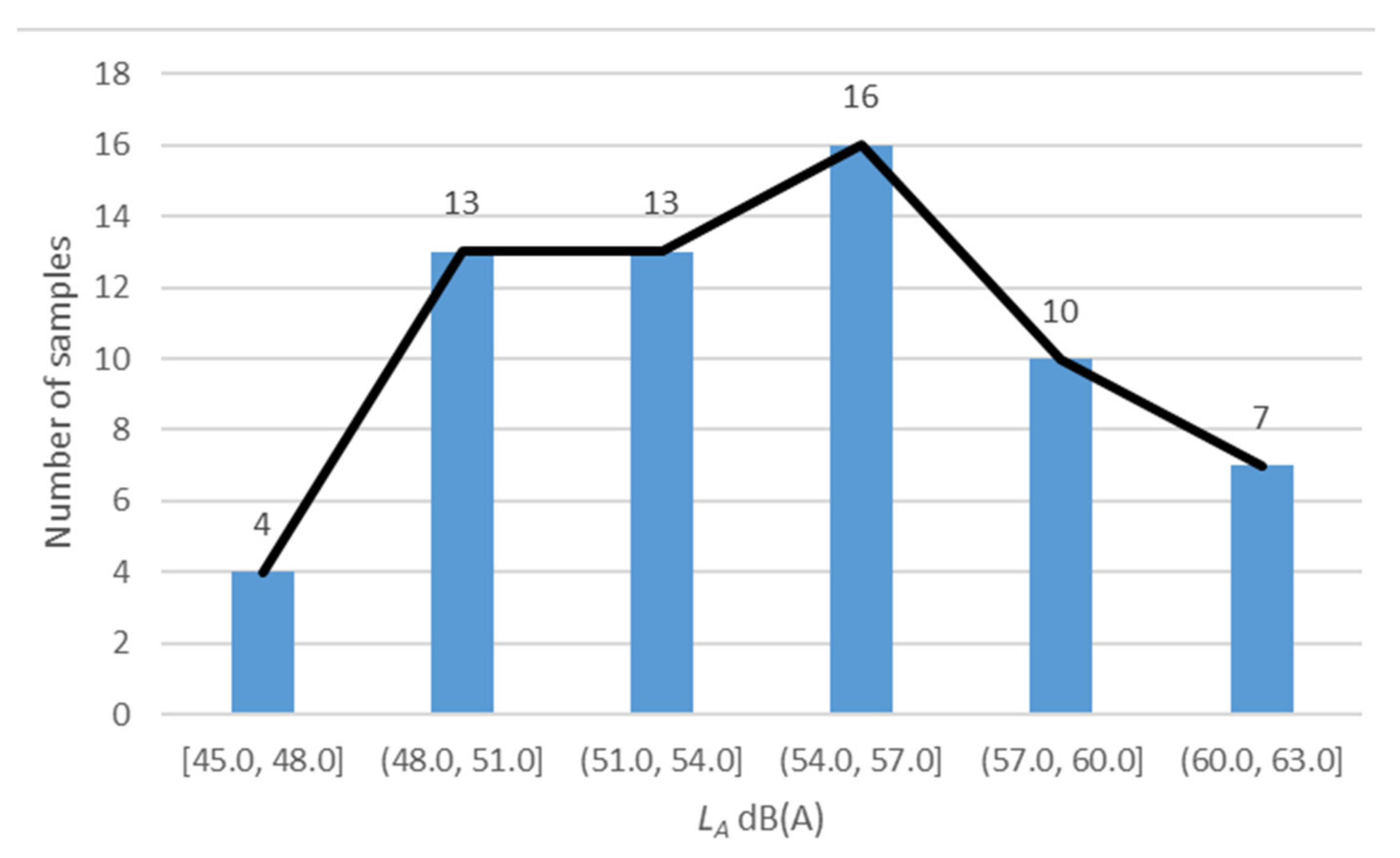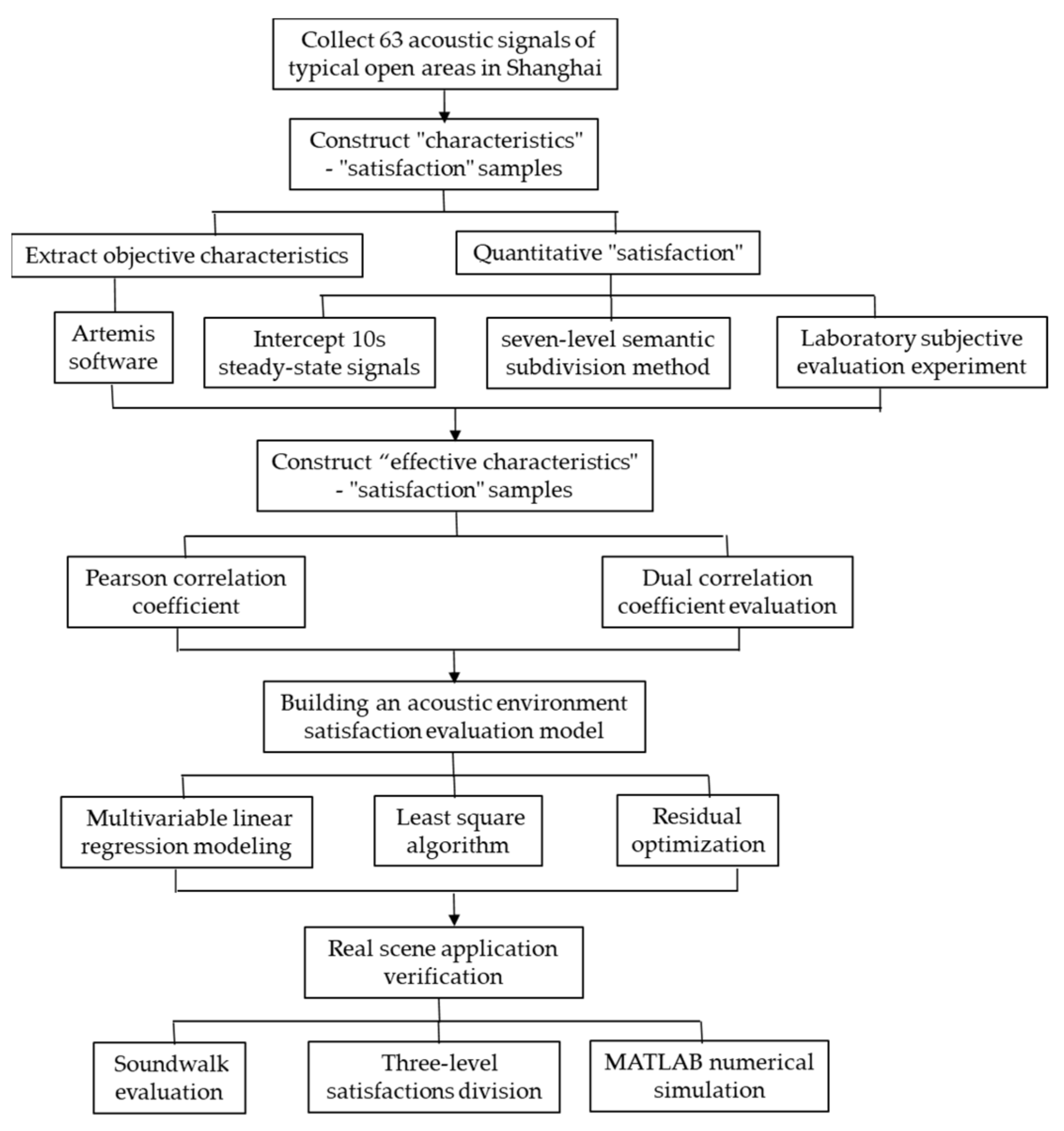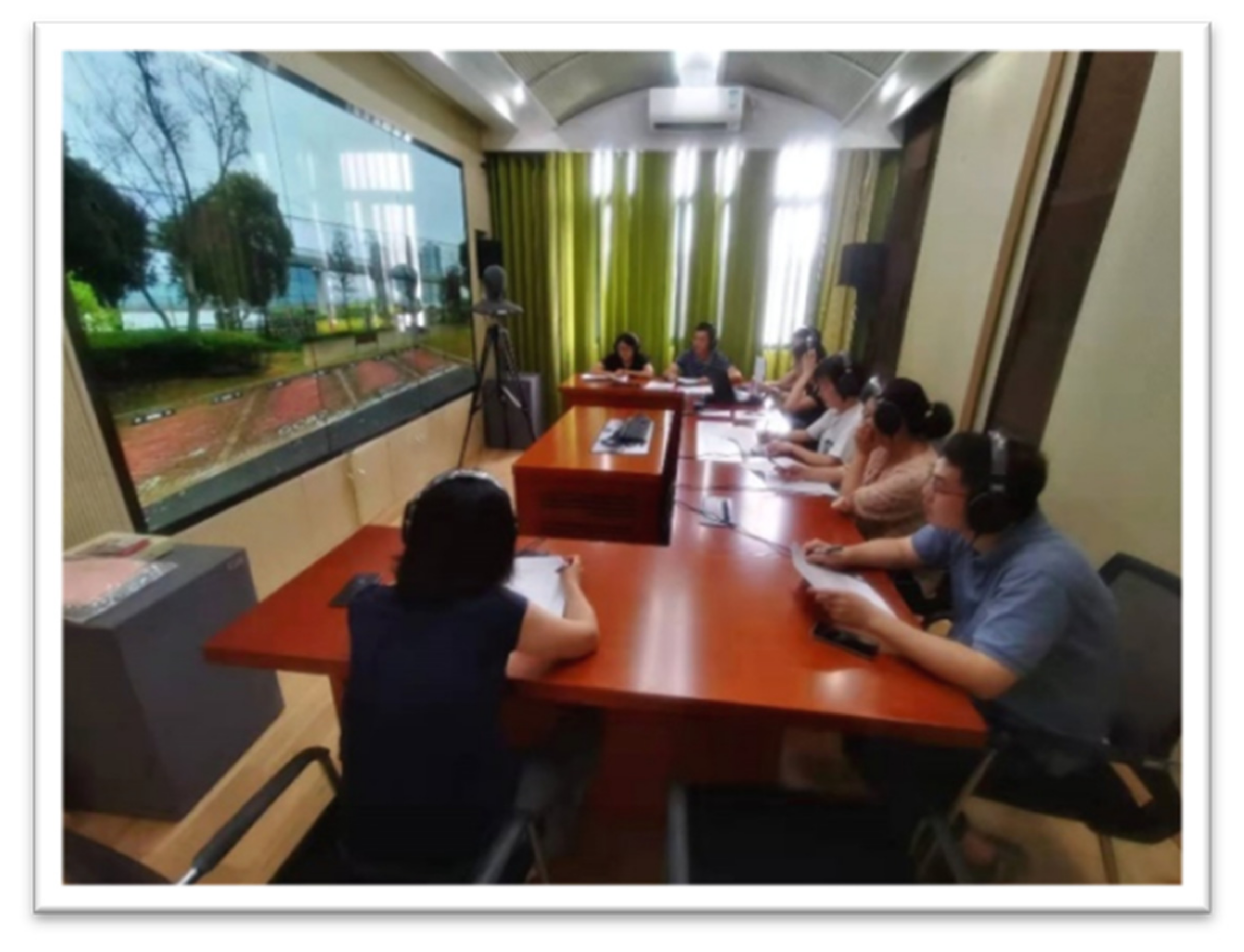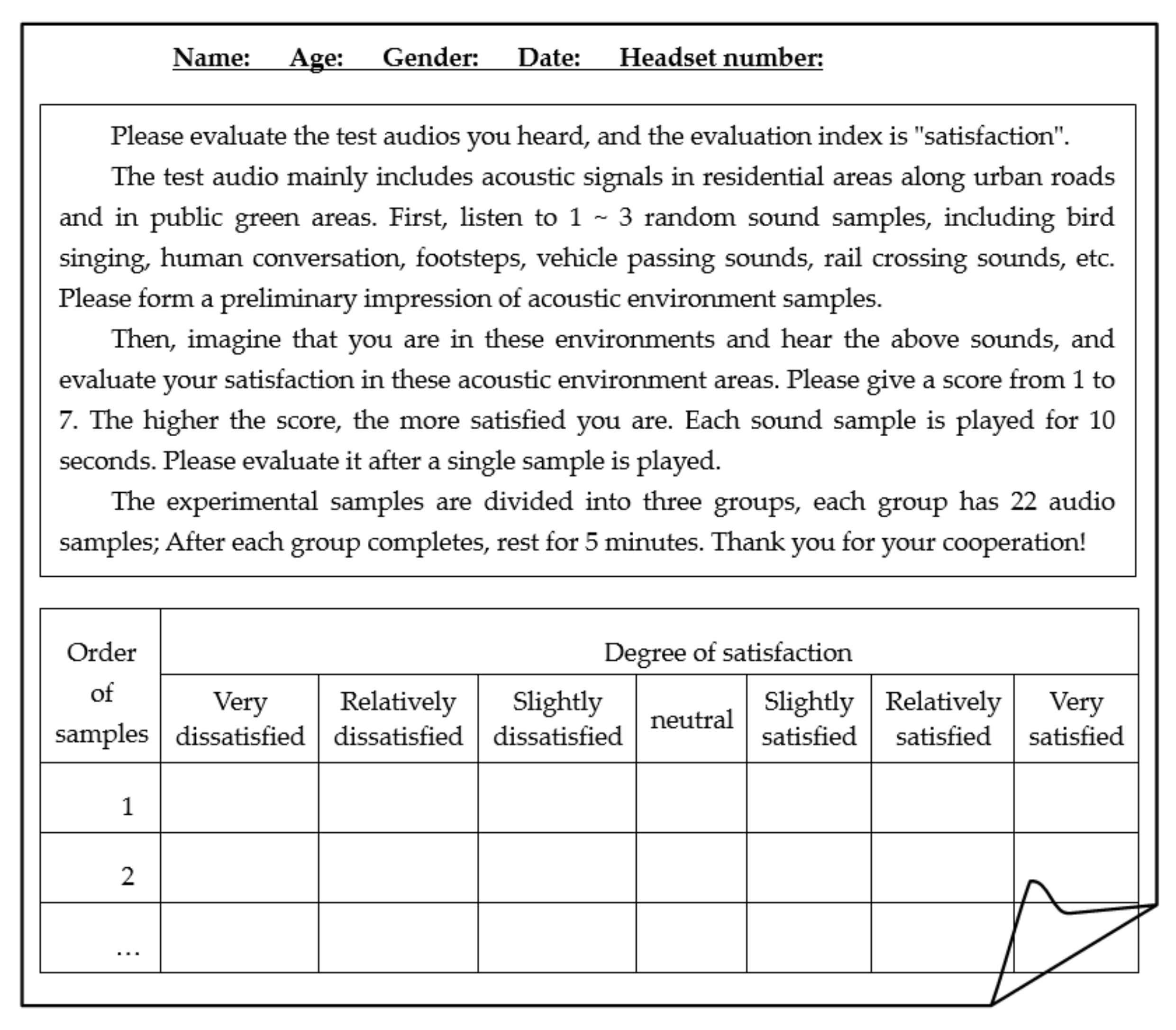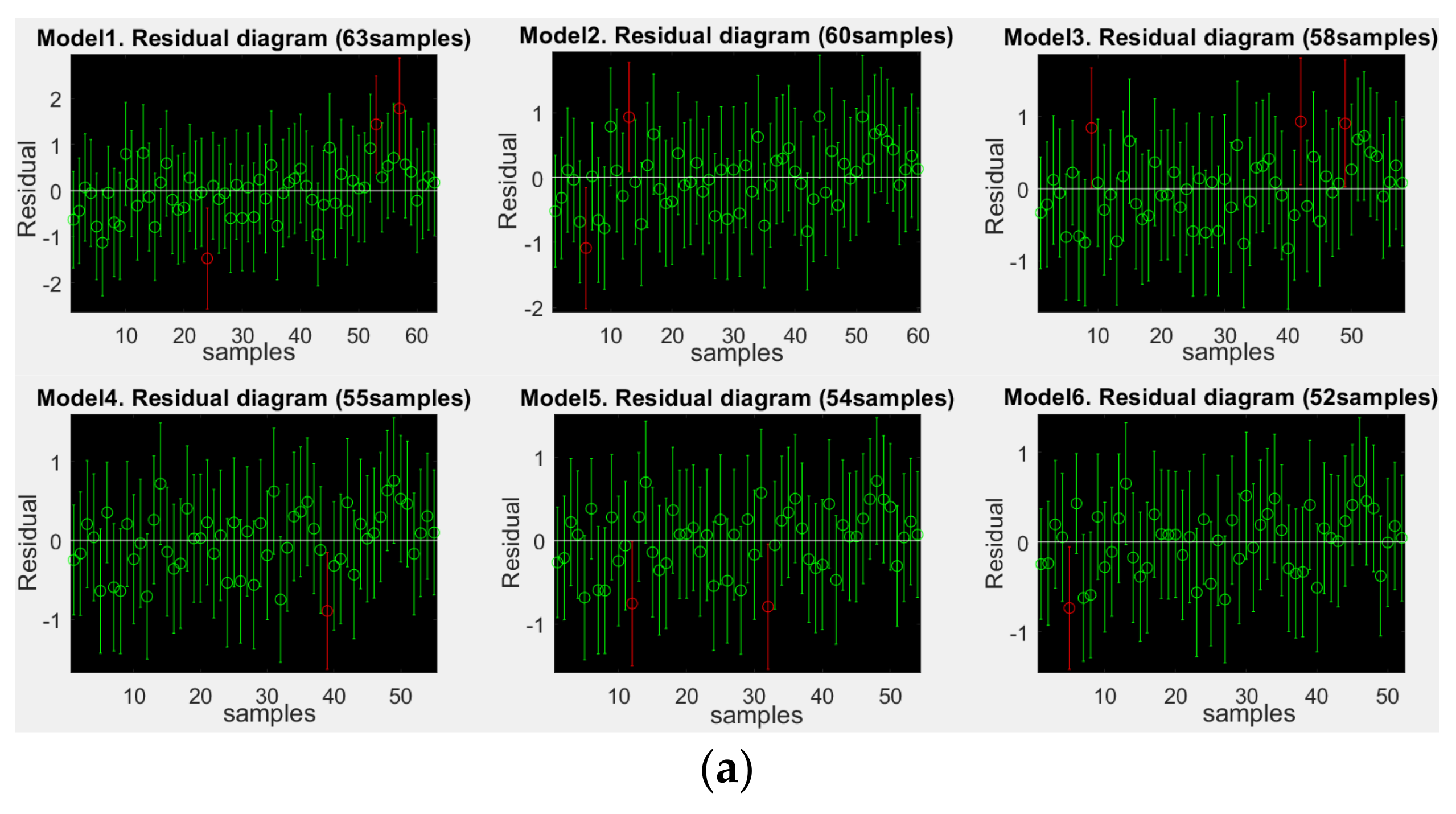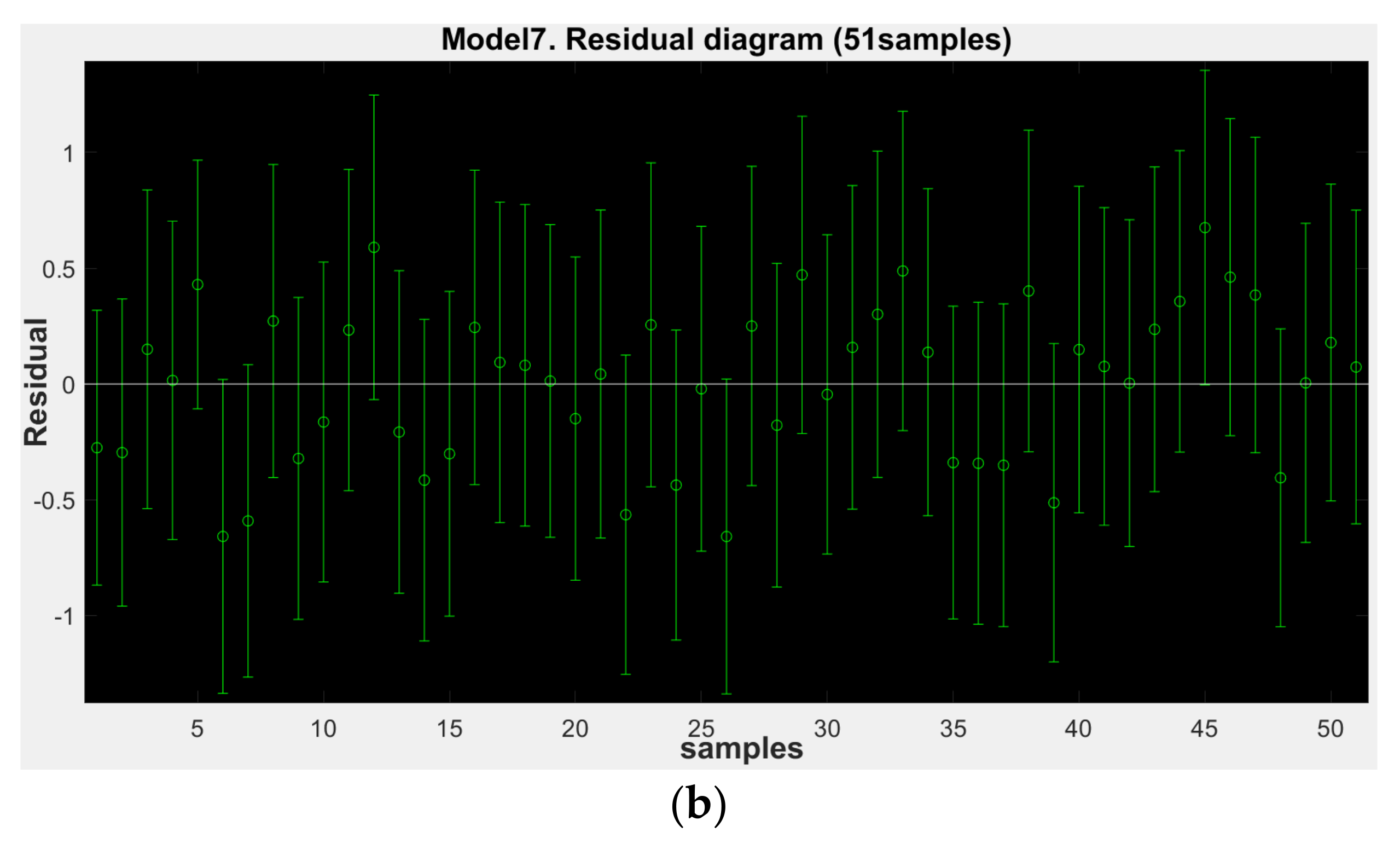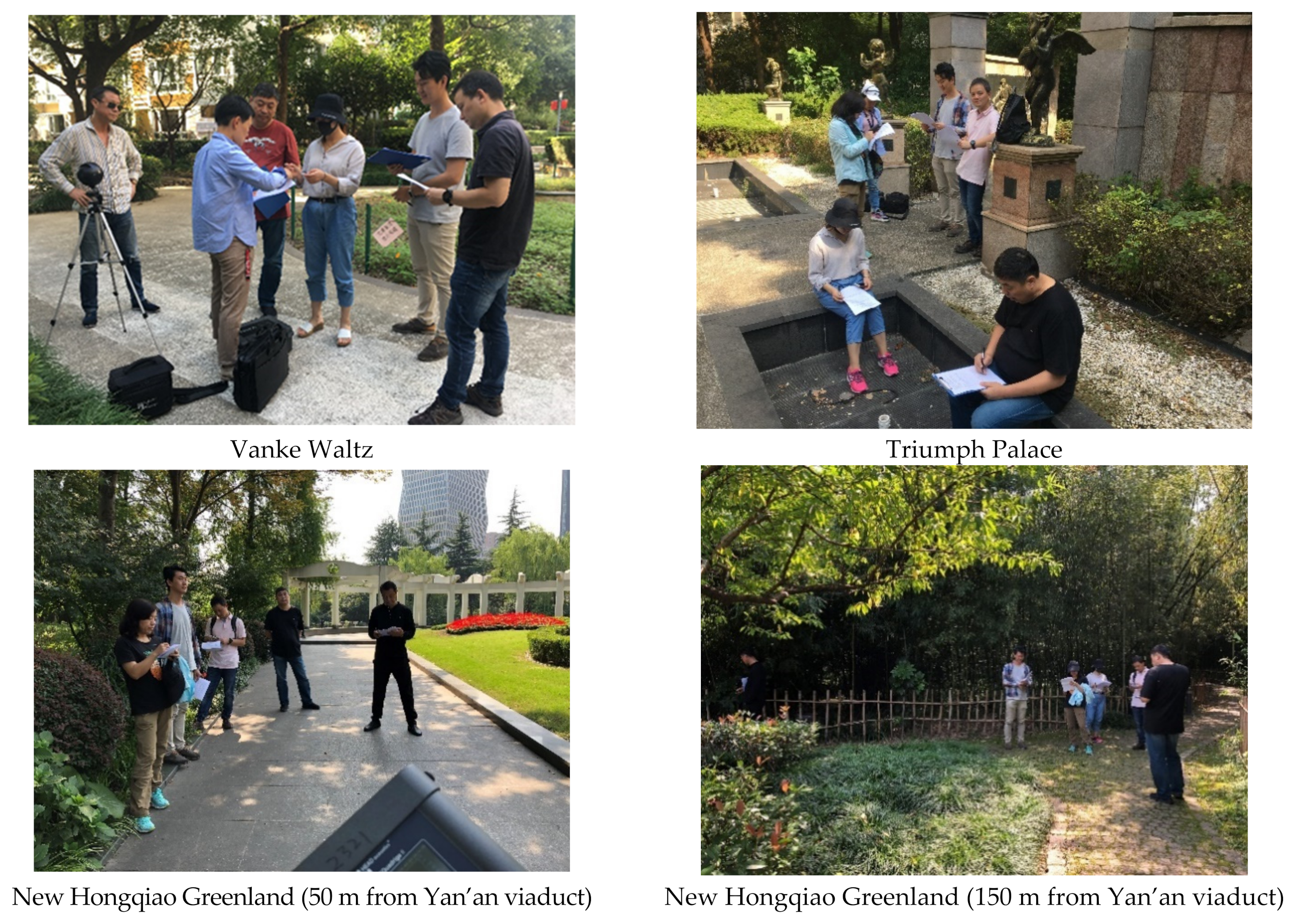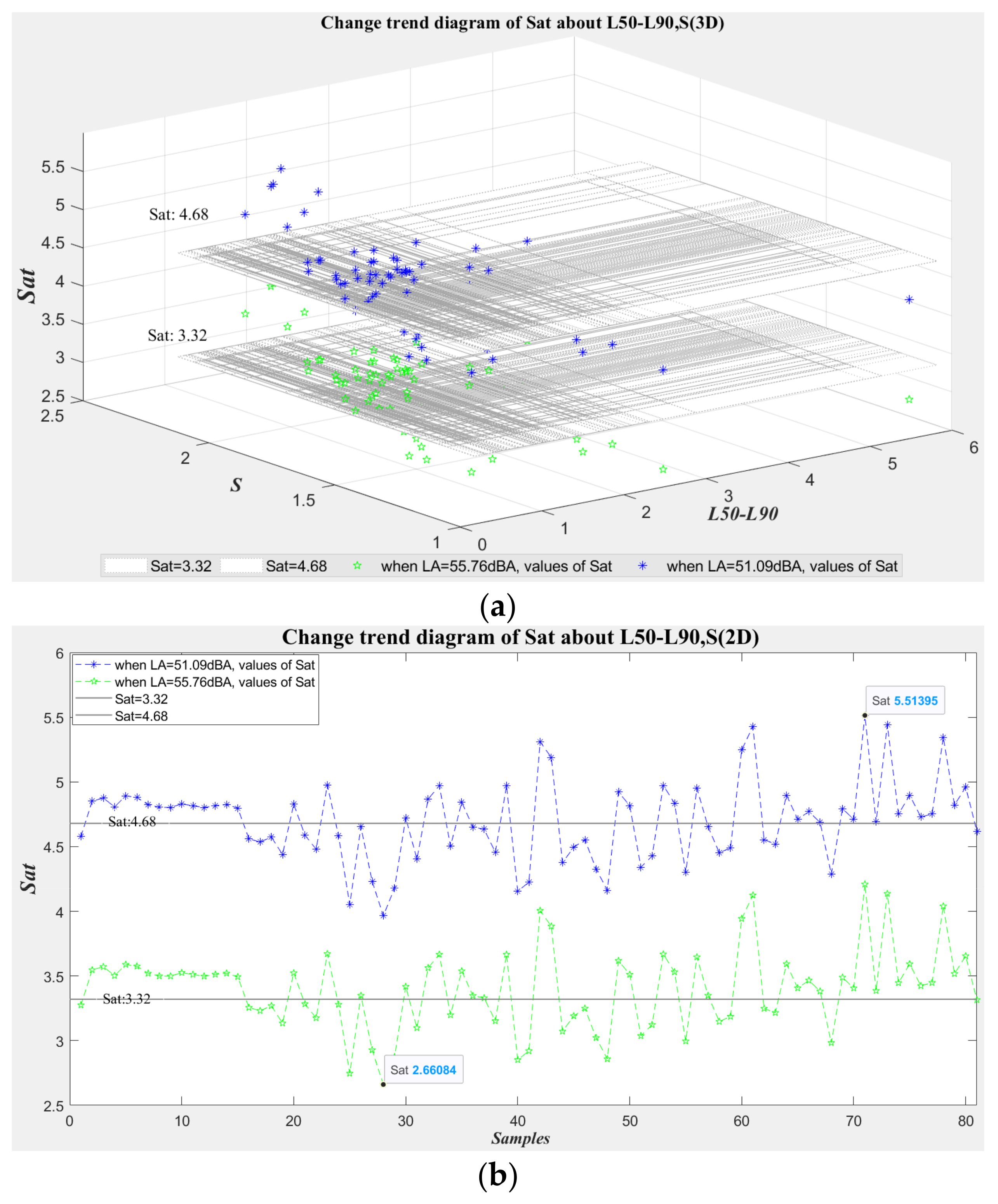1. Introduction
In a report about the impact of noise on health, i.e., the disease burden caused by noise pollution, published by the cooperative research center of the World Health Organization and European Union, it was pointed out that the disease burden caused by noise pollution is second only to air pollution [
1,
2]. With the continuous acceleration of China’s urbanization level, the urban scale of densely populated cities represented by Shanghai, Beijing, Guangzhou and Shenzhen has been continuously expanding and the population density is increasing in recent years, which has brought huge traffic flow and dense buildings. Throughout the layout of large- and medium-sized cities, residential areas are generally distributed along both sides of urban primary and secondary traffic arteries. Urban open spaces (including residential areas, urban public green spaces and other areas for residents’ daily leisure and activities) are inevitably affected by all kinds of traffic noise. Urban noise pollution has become an important environmental factor affecting quality of life and human health [
3,
4].
Traditionally, physical indicators, such as equivalent continuous A-weighted sound pressure level (
LA) are used to quantitatively evaluate noise. However, the main impact of noise on humans is to cause subjective feelings, such as annoyance [
5,
6]. From the perspective of auditory perception, the ultimate goal of noise control is to reduce the annoyance caused by noise. In recent years, scholars have begun to pay more attention to “people-oriented,” explore the evaluation method based on subjective perception, and try to apply it to the field of urban acoustic environment quality control [
7,
8,
9,
10].
Research on the subjective evaluation of the acoustic environment began in the 1970s. Schultz obtained the exposure response relationship of noise by data fitting between the annoyance ratio of residents and the day and night equivalent sound pressure level Ldn in many European and American cities [
11]. Since then, studies on the relationship between sound pressure level characteristics and annoyance responses have emerged at home and abroad. However, these studies have always focused on the impact of a single
LA on subjective annoyance [
12,
13,
14,
15,
16,
17,
18]. At the end of the 20th century, A. Kjellberg, K. Persson, J.S. Bradley and other researchers found that other components of sound have a certain impact on human subjective feelings [
19,
20,
21]. A single study on the impact of
LA on subjective perceptions makes it difficult to fully reflect real human feelings about the acoustic environment. At the beginning of the 21st century, scholars have considered various (physical and psychological) characteristics other than sound pressure level to study the subjective evaluation of the acoustic environment (in a specific space), and some research results have been achieved [
7,
22,
23,
24]. In 2009, Yu and Kang of the University of Sheffield built the sound pressure level evaluation model and sound comfort evaluation model of British city squares based on sound pressure levels [
25,
26]. Since then, subjective evaluation models of acoustic environments based on physical and psychoacoustic characteristics have gradually become research hotspots in the acoustic subjective evaluation field. Aiming at the independent sound sources in residential areas, Lu discussed the acoustic comfort evaluation model based on the characteristic parameters of sound pressure level, loudness and clarity [
27]. In recent years, considering acoustic objective parameters such as sound pressure level, loudness, roughness, sharpness, tone and shaking degree, the Kang J team has explored sound comfort evaluation models for single sound sources, including running water sound, bird sound and car sound [
28]. On this basis, Yu and Xu further built a sound source evaluation model [
29].
Throughout the research status at home and abroad, most of the current research on subjective evaluation of the urban acoustic environment is still focused on a single or similar sound source (such as running water sound, car sound, bird singing, etc.) [
28,
29,
30], as well as a single urban space type, such as a specific urban square, park, residential area, street, commercial street, etc. [
25,
26,
27,
30]. These small-scale studies are difficult to apply to evaluate the overall urban acoustic environment with complex and mixed sound sources. Moreover, on the one hand, existing studies often separate the sound pressure level from other acoustic characteristics and divide the subjective acoustic evaluation into sound level evaluation and sound source evaluation [
25,
26,
28,
29,
31], ignoring the interaction between the acoustic characteristics and their compound influence on human subjective perception. On the other hand, existing studies often use various acoustic characteristics with significant correlations to build the subjective evaluation model at the same time [
28,
29], which makes the model with a large amount of redundant information, makes it difficult to obtain the effective characteristics for subjective evaluation of the acoustic environment, and increases the complexity of the evaluation model. Therefore, the extraction of “effective characteristics” and the creation of a scientific and efficient subjective evaluation model that is applicable to the overall urban acoustic environment evaluation have always been the key technical problems to be solved.
In this paper, the “effective characteristics” and the subjective satisfaction model for evaluating the overall quality of the urban acoustic environment are studied quantitatively. Based on effective physical and psychoacoustic characteristic parameters and subjective parameters obtained in previous studies [
32,
33,
34,
35,
36,
37], adopting the multivariate linear regression modeling method, the paper builds a subjective satisfaction evaluation model of the acoustic environment based on “effective characteristics”. The soundwalk evaluation comparison experiment and MATLAB numerical simulation experiment are employed to verify the applicability and superiority of the proposed satisfaction model. The research expands the spatial scale and sound source complexity of the subjective evaluation and also provides a technical basis for establishing the scientific and efficient evaluation indexes and evaluation methods of urban acoustic environment quality.
The rest of the paper is organized as follows. In
Section 2, firstly, the “effective characteristic” parameters for acoustic environment evaluation are explained and a sample set of “effective characteristics” − “satisfaction” is constructed. Then, a satisfaction evaluation model based on “effective characteristics” is proposed in this section. Verification of the performance of the proposed satisfaction evaluation model is performed in
Section 3 by employing a soundwalk evaluation experiment and a MATLAB numerical simulation test. In
Section 4, the conclusions are presented.
3. Real Scene Application Verification of Acoustic Environment Satisfaction Evaluation Model
3.1. Soundwalk Evaluation Experiment
The soundwalk evaluation method is a commonly used experimental method for sound subjective research and sound scene research [
43,
44]. The soundwalk evaluation method requires experimenters to evaluate the sound environment at the designated place in the urban green space and the hinterland of the residential area, and the acoustic signals are collected simultaneously. According to the international standard of soundscape ISO/TS 12913-2:2018 [
45], to prevent mutual interference, the number of soundwalk experimenters should be about 5. The evaluation points shall be set in advance according to the site conditions. It is necessary to select the points that can represent the characteristics of the acoustic environment in the area, ensure the consistency of the environment evaluated by the experimenters and avoid the interference of sudden noise events. Compared with the laboratory evaluation method, the soundwalk evaluation method can better reflect the intuitive feelings of the crowd in the current acoustic environment [
43,
44,
46].
In this paper, three representative open spaces, including the viaduct, ground road and rail transit line, are randomly selected for the soundwalk experiment on site to obtain the actual evaluation values of the crowd. The acoustic environment signals of the points in the three spaces are collected synchronously; then, the corresponding prediction values of satisfaction are calculated by using the satisfaction evaluation model proposed in this paper. At the same time, the LA-Sat evaluation model (i.e., the linear fitting function of subjective satisfaction Sat on a single characteristic LA) is used to predict the acoustic environment satisfaction of these points. Then, the superiority of the proposed subjective evaluation model based on “effective characteristics” is verified in this section. On the one hand, by comparing the deviation degree and satisfaction level consistency between the prediction values of the proposed model and the soundwalk evaluation values, the prediction accuracy and field applicability of the proposed satisfaction evaluation model are evaluated. The superiority of the proposed satisfaction model is further verified by comparing the prediction accuracy with the LA-Sat evaluation model. On the other hand, the MATLAB numerical simulation test is used to evaluate the impact of characteristics L50 − L90 and Sh on subjective satisfaction Sat when the value of LA remains unchanged, so as to verify the effectiveness of “effective characteristics” for the evaluation of urban acoustic environment quality.
The design of the experimental points and experimental schemes of the field soundwalk experiment are shown in
Table 5. The scenes of the soundwalk evaluation experiment are shown in
Figure 6, including soundwalk evaluation, scene recording, and sound signal collection. A total of 6 experimenters (including 4 men and 2 women) were randomly selected from the experimental personnel who participated in the subjective evaluation in the laboratory in the early stage. They evaluated the degree of satisfaction with the acoustic environment in different periods according to the gestures of the soundwalk conductor. The seven-level semantic subdivision method is still used.
Figure 7 shows the subjective evaluation list of the soundwalk experiment.
3.2. Analysis of Prediction Accuracy and Superiority of the Model in Real Scenes
The correlation analysis is carried out on the soundwalk evaluation results of 6 experimenters. The average value of the correlation coefficient is 0.77, and the lowest value is 0.67. That is, the evaluation results of 6 experimenters are basically the same, which are all valid data.
3.2.1. Accuracy and Regional Applicability Verification of the Effective Characteristics-Sat Model
On the one hand, to compare the prediction accuracy between the proposed
Effective Characteristics-Sat model and
LA-Sat evaluation model, the performance index Mean Absolute Percentage Error (
MAPE) is used to evaluate the deviation degree between the prediction values of the models and the soundwalk evaluation values, which can be calculated as Equation (18). On the other hand, in order to show the consistency between the prediction results of the proposed model and the evaluation results of soundwalk more simply and intuitively, and reduce the complexity of the evaluations of the model (improve the practicability of the proposed model for the evaluation of urban regional acoustic environment quality), it is considered to simplify the satisfaction evaluation results of levels 1~7 into three level intervals of “dissatisfaction,” “neutral “ and “satisfaction,” so as to verify the consistency of subjective satisfaction levels. Specifically, by ranking the 63 groups of satisfaction evaluation values of laboratory subjective experiments from low to large and counting the evaluation results of the seven-level semantic subdivision method, it is found that the “neutral” evaluations of experimenters are basically concentrated near the score of 4. Therefore, 3.32~4.68 is defined as the “neutrality” interval, which corresponds to the number of experimenters evaluating “neutral” (i.e., score 4) as close to half. Then, the satisfaction evaluation values of levels 1~7 can be simply divided into “neutrality” with an interval of 3.32 <
Sat < 4.68, “dissatisfaction” interval of
Sat ≤ 3.32 and “satisfaction” interval of
Sat ≥ 4.68 [
33].
where
m represents the number of soundwalk samples,
and
represent the satisfaction prediction value and the soundwalk evaluation value of the
i-th sample, respectively.
The predictions of the satisfaction evaluation model proposed in this paper and the soundwalk evaluation results for the acoustic environment in three representative open areas are compared in
Table 6 and
Table 7.
Table 6 shows that the
MAPE value of prediction values of the proposed model and the evaluation values of soundwalk is about 7.66%, and the
MAPE value of the predictions of the
LA-Sat evaluation model and the soundwalk evaluation values is about 10.06%, indicating that the prediction accuracy of the acoustic environment satisfaction of the soundwalk areas of the proposed evaluation model is 92.34%, which is better than the prediction accuracy of the
LA-Sat model of 89.95%, which verifies the accuracy superiority of the proposed model. As shown in
Table 7, after rating the prediction values of the proposed model and the evaluation values of the soundwalk according to 1–3 levels of satisfaction, the consistency of the satisfaction levels is 88.89%. The satisfaction levels of the prediction values of the model and the evaluation values of the soundwalk are basically the same. The two samples with different satisfaction levels listed in
Table 7 are for a short one-minute period; the soundwalk evaluations are disturbed by the unsteady part of the short-term sound. After excluding the evaluation samples for a 1-min period, the prediction accuracy of the proposed satisfaction model for the test areas is increased to 93.36% (as shown in
Table 6), and the satisfaction levels of the prediction values and the soundwalk evaluation values are completely consistent (as shown in
Table 7). In addition, as can be seen from the satisfaction rating results in
Table 7, differing from the soundwalk evaluations easily disturbed by short-term sudden noise events, the satisfaction levels of the model prediction values of acoustic environment signals of different time lengths in the same region are consistent. This indicates that the proposed satisfaction evaluation model based on “effective characteristics” has time robustness, and the predictions of the model are less disturbed by the unsteady part of the short-term sound signal. Therefore, based on the verification results in the subsection, the acoustic environment satisfaction evaluation the model based on the “effective features” proposed in this paper has superior prediction accuracy and field applicability. The three-level satisfaction division method can simplify the evaluation results of the proposed model and then improve the practicability of the model. In addition, the prediction accuracy of the model is not limited by the duration of the acoustic signal, which can fully describe the long-term subjective feeling for a regional acoustic environment with a steady-state sound signal for just 10 s. The evaluation method based on model can avoid external interferences that are difficult to eliminate in the traditional soundwalk evaluation.
3.2.2. Superiority Verification of the Effective Characteristics-Sat Evaluation Method
To further verify the superiority of the proposed acoustic environment satisfaction evaluation method, in this subsection, the impact of the other two “effective characteristics,” L50 − L90 and Sh, on the prediction value of subjective satisfaction is evaluated under the condition that the LA remains unchanged. Because it is difficult to collect a large number of acoustic environment samples with the same LA in real areas, this paper uses existing experimental samples collected in typical open areas (a total of 81 groups of acoustic signals) to conduct numerical simulation tests with the MATLAB platform. Specifically, considering the LA-Sat evaluation model depending solely on LA, the sound level interval corresponding to the subjective evaluation of “dissatisfaction” is obtained as LA ≥ 55.76 dB (corresponding to Sat ≤ 3.32), and the LA interval subjectively evaluated as “satisfaction” is LA ≤ 51.09 dB (corresponding to Sat ≥ 4.68). To more simply and intuitively verify the influence of the change of the characteristic parameters L50 − L90 and Sh on the subjective Sat in the proposed model, here, the sound level values LA of the simulation samples are taken as 55.76 dB(A) and 51.09 dB(A), respectively. In combination with the 81 characteristic values of L50 − L90 and Sh collected in the previous experiments, two groups of simulation experiment sample sets (each group containing 81 samples) are constructed by using MATLAB. Then, the satisfactions SAT55.76dB(A) and SAT51.09dB(A) of two groups of data samples are predicted using the satisfaction evaluation model based on the “effective characteristics” proposed in this paper.
Figure 8 shows the (3D/2D) change trends of SAT
55.76dB(A) and SAT
51.09dB(A) on the characteristic parameters
L50 −
L90 and
Sh. It can be seen from
Figure 8 that the values of subjective satisfaction
Sat are obviously affected by the changes in sharpness
Sh and
L50 −
L90 when the
LA remains unchanged. As shown in 3D
Figure 8a, the higher the value of
Sh and the lower the value of
L50 −
L90, the higher the value of
Sat. Moreover, compared with the impact of
L50 −
L90 on
Sat, the impact of
Sh on
Sat is more significant. 2D
Figure 8b more intuitively shows the changes in
Sat of the 81 × 2 samples. In
Figure 8b, the first 18 × 2 samples are from the soundwalk experimental samples, the background acoustic environment of these samples is similar, and the values of the characteristics
L50 −
L90 and
Sh of the acoustic samples differ slightly. Therefore, the change range of the satisfaction values is also small, and they are basically concentrated in the same satisfaction level. Among them, there are four samples (the first and the 16th–18th samples) with obviously smaller values of characteristics
Sh, so their values of
Sat are obviously reduced. The last 63 × 2 samples in the figure show significant change trends in the values of
Sat due to a wide range of collected areas and large changes in the background acoustic environment. In general, as can be seen in
Figure 8, the evaluation values
Sat fluctuate within “dissatisfaction” and “neutrality” depending on the change of the values of characteristics
L50 −
L90 and
Sh when
LA = 55.76 dB; the evaluation values
Sat fluctuate within “satisfaction” and “neutrality” with the change of characteristics
L50 −
L90 and
Sh when
LA = 51.09 dB. Therefore, from the satisfaction prediction results in this subsection, it can be seen that the proposed “effective characteristics” more comprehensively describe humans’ subjective feelings in the regional acoustic environment compared with a single
LA index. Compared with the traditional subjective evaluation method based on sound pressure level, the satisfaction evaluation model based on “effective characteristics” proposed in this paper has higher prediction accuracy for the acoustic environment of various open spaces.
3.3. Discussion of Applicability and Superiority
The subjective satisfaction model proposed in this paper is applicable to evaluate the acoustic environment of open space of the urban class 2 sound functional areas (including residential areas, urban public green spaces and other areas for residents’ daily leisure and activities), which are affected by all kinds of traffic noise. Compared with the existing studies on subjective evaluation, which mostly focus on a specific space and single/similar sound source, the proposed model expands the space scale and the complexity of sound sources of subjective evaluation. Compared with the existing research on subjective evaluation models, which either only consider a single sound pressure level or use various significantly related acoustic characteristics to establish an evaluation model at the same time, the proposed subjective evaluation model based on “effective characteristics” improves the evaluation accuracy and eliminates a large number of redundant characteristic parameters. The study simplifies the number of evaluation indicators to the greatest extent and reduces the complexity of the evaluation model. Therefore, the satisfaction evaluation model based on “effective characteristics” proposed in this paper provides technical support for the regional acoustic environment quality evaluation of large- and medium-sized cities and also provides a research direction for the improvement of regional acoustic environment quality standards. In addition, by studying the “modification” and “fine adjustment” of the “effective characteristics” of sounds, the acoustic environment quality of open space will be accurately improved so as to improve people’s quality of life.
4. Conclusions
In this paper, the subjective evaluation of the overall acoustic environment of the urban class 2 sound functional open areas (including residential areas, urban public green spaces and other areas for residents’ daily leisure and activities) is studied. In the early stage, the “characteristics” − “satisfaction” sample set was obtained by collecting the acoustic environment signals of various open areas in Shanghai and establishing the subjective evaluation experiment in the laboratory. Then, by studying the dual correlations of 16 kinds of objective characteristic parameters and the subjective parameter “satisfaction,” three “effective characteristic” parameters for subjective evaluation of the acoustic environment were proposed, including LA, L50 − L90 and Sh.
Based on previous research results, the mathematical relationship between “effective characteristics” and “satisfaction” is quantitatively studied in this paper. Using the multivariate linear regression modeling method, a subjective satisfaction evaluation model of the acoustic environment based on “effective characteristics” is built. After several residual optimizations, the regression accuracy of the model is more than 96%, which verifies the effectiveness of the built satisfaction evaluation model. Furthermore, representative typical open areas in Shanghai are selected to study the field application of the proposed evaluation model in real scenes. The result of the soundwalk experiment verifies that the prediction accuracy of the Effective Characteristics-Sat evaluation model for soundwalk areas is more than 92% (obviously higher than the prediction accuracy of the traditional LA-Sat model), and the consistency of the satisfaction levels is more than 88%. The numerical simulation results show that the changes in the values of Sh and L50 − L90 have a significant impact on the satisfaction prediction of the proposed model when the LA is unchanged. That is, compared with the traditional subjective evaluation method based on a single sound pressure level, the proposed “effective characteristics” more comprehensively describe the quality level of the regional acoustic environment, and the satisfaction evaluation model based on “effective characteristics” has superior evaluation accuracy and regional applicability.
